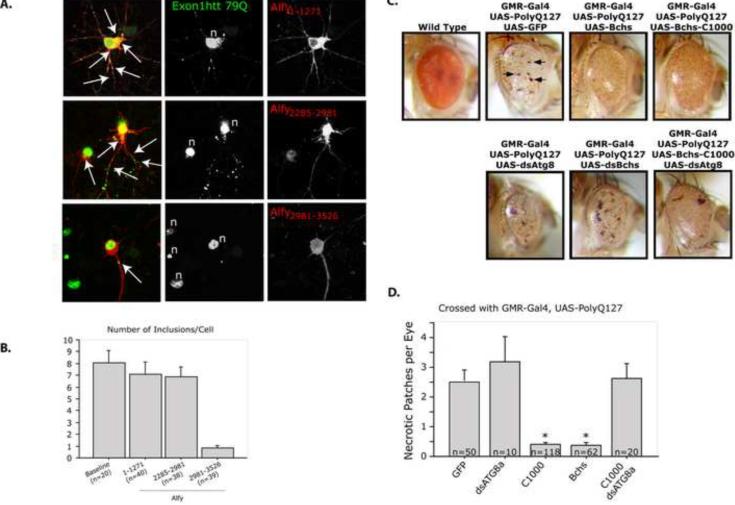Figure 6.
Alfy/Bchs overexpression leads to a disappearance of inclusions in a primary neuronal model of HD and diminished neurotoxicity in a Drosophila eye model of polyQ toxicity. A,B. Alfy overexpression in a lentiviral model of HD leads to fewer inclusions in rat primary cortical neurons. A. IF against exon1Htt (green) with MAB5492 reveals that transduced neurons exhibit robust aggregation throughout the cell, including the soma and processes (white arrows), and nuclei (n). Transfection of Alfy1–1271 (p=0.4241) and Alfy2285–2981 (p=0.3325) had no noticeable effect on the number of inclusions/neuron. In contrast, expression of Alfy2981–3526 led to a significant reduction in the aggregate load in the neurons (p<0.001). The visible green puncta in the field that do not co-localize with red are attributable to neuronal processes from non-Alfy transfected neurons. B. Number of inclusions per cell was counted in the number of cells indicated. All visible puncta within a 100 m radius from the center of the nucleus were counted. Cells were considered within the cell if the puncta (green) co-localized to cytosol expressing the tomato fluorophore (red). C,D. Alfy/Bchs overexpression in the Drosophila eye leads to protection against polyQ toxicity. C. Canton-S control flies (wild type) show the normal pigmentation profiles and ommatidial features of the adult Drosophila eye. Expression of polyQ127 peptide (UAS-PolyQ-127, n=20) using the pGMR-Gal4 driver leads to distinctive defects throughout the eye including necrotic regions (pGMR-Gal4/UAS-PolyQ-127, arrows, n=20). Co-expression of full-length Bchs (pGMR-Gal4, UAS-PolyQ-127/UAS-EP-bchs, n=20) reduced the level of observable necrosis. Co-expression of PolyQ127 peptide with the C-terminal region of Bchs (pGMR-Gal4, UAS-PolyQ-127/UAS-bchs-C1000, n=20) leads to suppress this external toxic phenotypes. Co-expression of a dsAtg8a (pGMR-Gal4, UAS-PolyQ-127/UAS-bchs-C1000/UAS-dsAtg8a, n=15) RNAi transgene blocked this protective effect. D. The number of necrotic regions was determined for C. While co-expression of dsAtg8a further reduced eye size it did not significantly alter necrosis levels (p=0.2391). Both full-length and C1000-Bchs significantly reduced fly eye necrosis (p<0.0001). This decrease was abrogated when C1000 was co-expressed with a dsRNA against ATG8a (p=0.9977), which significantly inhibits macroautophagy in the developing eye. Complete statistics can be found in Supplemental Materials under Statistical information for Figures.

